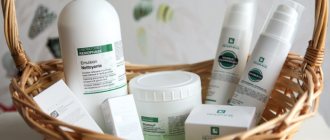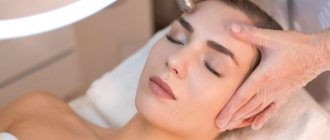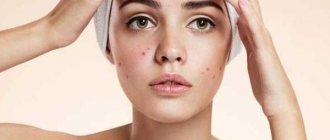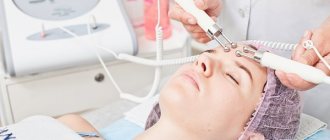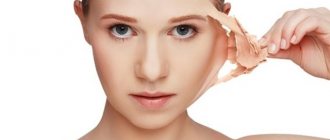The most popular question in modern cosmetology that concerns any woman is how to choose a high-quality, and most importantly, effective peeling for the face without compromising health and aesthetics. There is no universal answer because the best peels are a personal and controversial concept. What professional procedures are there, and what skin types they are suitable for.
The history of facial peelings
Facial peeling (exfoliation) is a cosmetic procedure aimed at exfoliating (removing) the upper keratinized layer of the epithelium. Translated from English, this term means “removing the husk,” which most accurately reflects the essence of the method. By cleansing the skin of dead cells, the effect of renewal and rejuvenation is achieved, the complexion improves, and mechanisms of accelerated cell regeneration are launched.
The history of facial skin resurfacing goes back a long way. This is the oldest known cosmetic technique. It was first used in Ancient Egypt and Mesopotamia. Exfoliating mixtures in those days included crushed minerals and pieces of fruit seeds. The prototype of modern chemical peelings of the facial skin were compositions based on fruit and lactic acids, which beauties of ancient times treated their skin with. In the Middle Ages, more complex technologies and recipes using wine and grape juice appeared. Tartaric acid played the role of an active component that dissolves dead cells. But if used inappropriately, such products could cause a chemical burn to the skin of the face. Even then, researchers realized that after treatment with acidic compounds the skin should not be exposed to sunlight.
The latest research has discovered new properties of acids and their combinations for safe and effective facial peeling procedures. The modern beauty industry offers an extensive arsenal of products. Some of them effectively exfoliate dead cells mechanically (scrubs). Others improve the appearance of the skin using chemical peels. Still others start the regeneration process, additionally rejuvenate and saturate the skin with nutritional components. Many types of peelings for the face and body perform not only a cleansing, but also a healing function. They help get rid of comedones (blackheads), acne, age spots and other dermatological problems.
Home peeling recipes
Peeling can be prepared at home using available products. The choice of recipe is based on the desired result.
Whitening peeling
Compound:
- half a cucumber;
- egg white;
- 15 ml. lemon juice.
Method of preparation and use: finely grate the cucumber, add lemon juice and protein - mix. Apply the paste onto a cleansed face, avoiding the lips and eyes, and leave for 20 minutes.
Rinse off with warm water and rub the nourishing cream into your face. When walking in sunny weather, use sunscreen.
Anti-wrinkle remedy
Compound:
- 20 g. cottage cheese;
- 15 g honey;
- 3 g turmeric;
- 2 g nutmeg.
Method of preparation and use: combine and mix the ingredients. Apply the resulting mixture to a clean face, leave for 15 minutes, rinse with warm water, and moisturize with cream.
Rejuvenating peeling
Compound:
- coffee beans;
- rich sour cream/cream (for dry skin);
- low-fat kefir/yogurt (for oily skin).
Method of preparation and use: grind coffee, add sour cream or kefir, mix thoroughly. Apply the paste onto clean skin, and after drying, rinse with water.
Professional peelings: mechanism of action
The skin of the face is thin and delicate. It is most susceptible to the influence of adverse weather factors and ecology, which trigger age-related changes. Therefore, it is so important to provide proper care and prevent early withering and aging processes. The use of nourishing and moisturizing masks and creams benefits the skin, but it cannot trigger active cell renewal and regeneration. This effect is achieved by a more radical procedure – exfoliation (peeling) of the dermis.
The essence of the method is to remove the top, keratinized cells and cleanse the facial skin. During the cleaning process, intensive exfoliation of the stratum corneum occurs, which stimulates deeper cells to actively regenerate. Their accelerated division helps to heal and rejuvenate the epidermis, even out the tone, and eliminate minor defects. Young skin, freed from dead cells, intensively absorbs and absorbs nutrients, moisture and oxygen.
As a result, the cell renewal mechanism is launched, metabolic processes are activated, and the synthesis of collagen and elastin fibers is improved. This is necessary to maintain facial skin turgor and slow down the aging process.
FAQ
Why remove the stratum corneum at all, it will go away on its own over time?
Yes it is. If you are comfortable with dryness and flaking on your face (and this is how natural cell renewal occurs), then you do not need peeling.
Why is peeling done more often in autumn and winter?
Peeling injures the skin of the face. And the sun can aggravate the situation and cause the opposite effect of the procedure. During the autumn-winter period, the weather is cool and the sun's rays rarely touch our skin. But for prevention purposes, it is still necessary to apply a protective cream when walking.
Is it possible to choose peeling yourself without spending money on a consultation with a cosmetologist?
If your skin simply requires cleaning, that is, other than age-related problems, it has no problems, then you can try to carry out a simple acidic surface peeling yourself at home. Only after doing an allergy test.
Medium peeling is done only by a cosmetologist, there is nothing to say about deep peeling - even if you want, it is impossible to do it at home.
Peeling procedure: what problems does it solve?
Exfoliation of the skin helps solve many problems:
- cleansing the facial skin of dead cells, impurities, sebaceous plugs;
- improve the penetration of creamy textures that saturate epithelial cells with nutrients and oxygen;
- moisturize and refresh the upper layer of the epidermis;
- improve complexion, even out skin tone and texture;
- prevent the formation of new wrinkles;
- restore lymphatic drainage, eliminate swelling;
- activate the production of collagen fibers;
- prevent the development of inflammatory processes on the skin;
- slow down age-related changes;
- eliminate skin defects (pimples, comedones), lighten age spots;
- activate cell renewal, accelerate the processes of regeneration and restoration of the skin.
A properly performed cosmetic procedure rejuvenates the skin, making it firmer, tighter and healthier. The positive effect is achieved by exfoliating the top layer of keratinized cells, which create an obstacle to the timely regeneration and renewal of the skin.
Peeling - what is it and why is it needed?
The essence of the process is to cleanse the epidermis of dead, hardened cells. The beauties of Ancient Egypt, Greece and Rome did something similar, using tartaric acid, sour milk, and citrus juice. Nowadays, many types of this cosmetic manipulation are available to women, and she can decide which peeling to choose together with a cosmetologist.
The appearance of facial skin is constantly changing, exposed to many factors:
- the natural aging process;
- body health;
- ultraviolet radiation;
- polluted air, etc.
As a result, the epidermis becomes covered with small wrinkles, dark spots, scars, folds, and rashes. Cells die every 4 weeks. In the future, they clog the pores, preventing the flow of oxygen and the absorption of nutrients. To restore health and beauty to the skin, deep, medium or superficial cleaning is carried out. Thanks to her:
- dead particles are peeled off;
- metabolism improves;
- spots and redness are whitened;
- pores narrow;
- the regeneration process is accelerated.
After a course of procedures, the condition of the tissues improves, they can freely absorb useful components and oxygen. Firming masks enhance the effect. Manipulation is recommended for all women and girls over 18 years of age.
Impact zones
Peels are recommended for treating the following areas:
- Face – exfoliation is used to correct age-related changes and improve the appearance of the skin.
- Body – in combination with other procedures, body peeling helps get rid of cellulite, stretch marks, and improve the elasticity and firmness of the skin.
- Hair – the procedure is used to cleanse the scalp of dandruff, manifestations of seborrhea and dermatitis. In combination with massage and nourishing masks, it improves cell nutrition, blood circulation and metabolic processes, and stimulates hair growth.
The procedures must be performed by a professional cosmetologist who will correctly assess the condition, skin type, individual characteristics of the patient, and possible contraindications.
What types are divided into according to the depth of action?
Peeling in the salon is divided into 3 main types: superficial, medium and deep. As the names suggest, this division depends on the depth of penetration a particular method is designed for.
Let's take a closer look at what each subgroup includes.
Surface
An easy and gentle method, suitable for people without obvious skin problems. Superficial salon peelings affect the granular and stratum corneum of the skin. The procedure is carried out quickly, within 20-30 minutes, the course includes no more than 10 procedures.
After superficial cleansing, light redness, blackheads, and skin impurities are eliminated. It reduces acne, reduces skin oiliness, improves complexion, deeply moisturizes and nourishes, and eliminates early wrinkles.
For serious defects, this method will not demonstrate the desired effect. Having late age-related changes, severe scars and spots, it is worth trying a different technique.
Median
Medium facial peeling is prescribed for clients with serious age-related changes. All anti-aging cleansing methods used in beauty salons are based on this technique. It affects the deep layers of the epidermis, so it can be traumatic.
Medium peeling in beauty salons is carried out for expression and age wrinkles, strong scars, scars, potholes, stretch marks or folds. It is also a preparatory stage for plastic surgery.
Recovery from a midline peel can take up to 3 months.
Deep
The technique of deep facial cleansing is an aggressive, traumatic procedure. This method of cleaning is equivalent to operations. It is performed in a hospital setting, under anesthesia - both local and general. The choice of anesthesia depends on the area being treated and the client’s pain threshold.
The method allows achieving good efficiency. It eliminates deep wrinkles, double chins and jowls, and restores elasticity to tissues. It is recommended for women over 40 years of age who have severe oval sagging.
Restoration of the epidermis after deep cleansing lasts for six months or more.
Classification of facial peels
All procedures with a cleansing effect in cosmetology are divided into two categories - according to the degree of depth and type of effect.
The depth of penetration depends on the thickness of the stratum corneum and the general condition of the skin. Taking this parameter into account, facial peeling can be:
- superficial;
- average;
- deep.
Based on the type of impact, facial skin peels are:
- mechanical;
- chemical;
- hardware.
Each of these options has its pros and cons, application features, indications and contraindications. Let's take a closer look at the different options for the popular procedure.
Skin care after the procedure
The effectiveness of peelings is very dependent on subsequent care. Each type has its own characteristics, but some recommendations apply to all:
- Wash with water or foam without aggressive substances.
- Do not touch the crust at the site of peeling - otherwise it will take a long time to heal and have the opposite effect.
- Limit physical activity.
- Use moisturizing ointments daily and sunscreen when walking in sunny weather.
The deeper the peeling penetrates, the longer and more difficult the recovery period.
Types of peelings in cosmetology
Superficial facial peeling
This is the most comfortable and gentle option for cleansing the skin of the face and body, since the active substances do not penetrate deeply, providing only exfoliation of the top layer of skin.
To cleanse the skin mechanically, a variety of natural compositions with small solid particles that act as an abrasive are used. These are ground coffee beans, fruit seeds, crushed corals, rice grains, etc. A well-proven option is mechanical superficial facial peeling using brushes (brossage). Of the hardware methods for carrying out superficial cleansing of facial skin, the cavitation (ultrasonic) peeling method is best suited.
For superficial chemical peels of the face, preparations with fruit acids or compositions based on alpha hydroxy acids are used. They gently exfoliate cells without causing burns or irritation. A wide variety of acid compositions makes it possible to choose the best option for cleansing your facial skin. For procedures, malic, citric, lactic, tartaric, and mandelic acid are most often used.
Compositions based on retinoic, salicylic, and glycolic acid are popular. Intensive cell renewal, improved blood circulation and metabolic processes are promoted by superficial peelings of the facial skin with ascorbic or azelaic acid.
A low concentration of exfoliating solutions does not cause complications, pain and does not require rehabilitation time.
Indications
A gentle superficial peeling procedure is ideal for young skin. It refreshes the complexion well, brightens pigmented areas, dissolves sebaceous plugs in pores, eliminates inflammatory processes that provoke the appearance of acne. In addition, this method allows the active substances of other cosmetics to quickly penetrate the structure of the epidermis. Other indications include deterioration of complexion, post-acne, fine wrinkles, and a slight decrease in skin turgor. The superficial facial peeling procedure is ideal for young skin (up to 30 years).
Medium skin peeling
This type of exposure is based on the use of aggressive acidic compounds that penetrate the middle layers of the dermis. As active substances, preparations based on acids of higher concentration (trichloroacetic, salicylic, glycolic) are used.
Median exfoliation can also be performed mechanically. This procedure is called diamond peeling of the facial skin and is performed using special equipment equipped with diamond-coated brushes.
The midfacial peeling procedure is quite painful. After it, proper skin care is necessary during the process of rehabilitation and recovery. In one course you can do from 2 to 5 procedures, taking into account the skin type and the existing problem. Repeated cleansing sessions are allowed no earlier than six months later. There are also age restrictions. This type of exposure is not recommended for girls under 30 years of age.
Indications for medium facial peeling:
- increased keratinization of the epidermis (hyperkeratosis);
- loss of elasticity, appearance of deep wrinkles, sagging skin and other age-related changes;
- skin defects - acne, scars at the site of removed pimples (post-acne), age spots;
- manifestations of rosacea (red vascular network).
By acting at a certain depth, medium facial peeling can smooth out wrinkles, refresh the face, improve collagen production, narrow enlarged pores and even get rid of scars and flat warts.
Deep peeling of face and body
The active ingredients of chemical peels penetrate deep into the reticular layer of the dermis. For the chemical procedure of deep facial peeling, strong, aggressive acids of high concentration are used (trichloroacetic, phenolic). They also use mechanical dermabrasion or laser resurfacing.
This is the most painful and traumatic type of deep peeling of the face and body, which requires a cosmetologist to have a lot of experience, high qualifications and special care when carrying out the procedure. The deeper the effect on the dermis, the longer the period of rehabilitation and healing of the skin. Any mistake can lead to skin damage and complications. However, it is this type of deep peeling that gives the best aesthetic result and a pronounced rejuvenation effect.
Indications for deep peeling for face and body skin:
- removal of deep expression wrinkles;
- smoothing skin texture;
- elimination of rough scars and cicatrices;
- smoothing stretch marks;
- lightening of areas of hyperpigmentation.
The result of a deep facial peeling procedure is comparable to non-surgical cosmetic facelift techniques. The effect of lifting, rejuvenating and cleansing the skin lasts for a long time. But the rehabilitation period is also long – it will take at least 8 weeks for the skin to completely heal. When performing phenol facial peeling, restoration of the skin takes from 8 to 12 months. All this time, the skin needs to be taken care of, protected from ultraviolet radiation, and treated with wound-healing and antibacterial agents that prevent infection of the wound surface.
Contraindications
General contraindications that limit the possibility of using any type of facial peeling include:
- damage to the skin in the treatment area (scratches, abrasions, wounds);
- exacerbation of any dermatological diseases;
- the presence of inflammatory processes on the skin;
- acute stage of infectious or colds with hyperthermia (high temperature);
- individual intolerance to peeling compositions;
- herpetic infection,
- demodicosis (skin mite);
- mental disorders;
- oncological diseases;
- pregnancy, breastfeeding period.
Deep facial peeling with phenolic acid is a procedure that requires special care and attentive attention to the patient’s health. Phenol or carbolic acid is a highly toxic substance. A procedure using this component cannot be prescribed for pathologies of the liver and kidneys, diseases of the heart and blood vessels. In addition, any type of deep peeling of the facial skin (regardless of the method of execution) is prohibited if there are problems with the hematopoietic system and bleeding disorders.
Contraindications for peeling
Before embarking on the dilemma of which peel to choose, you need to study the limitations in the composition and methods of its application. All exfoliating procedures have some contraindications:
- any infectious diseases in acute form;
- allergic reaction to components;
- period of pregnancy and lactation;
- diseases of the cardiovascular system;
- liver and kidney problems;
- the presence of inflammatory processes;
- for cancer and asthma;
- the presence of a fresh tan;
- in case of violation of the integrity of the skin - wounds, abrasions, cuts, burns;
- diabetes;
- the presence of a large number of moles, warts, papillomas.
Professional facial peels should be used with caution in case of increased sensitivity of the skin and vascular network.
Methodology
Let's consider the technique of performing the most popular and sought-after procedures:
Mechanical peelings for facial skin
- Coral. The basis of the cleansing compositions are the smallest particles of coral, Dead Sea salts, essential oils, and exotic herbs. Before applying the drug, the facial skin is thoroughly cleansed of dirt and makeup residues. The powder base is diluted with water to the required consistency and applied to the skin with light massage movements. The procedure is quite comfortable, but for those with delicate skin it may cause mild pain. This type of mechanical peeling for the face helps eliminate enlarged pores, acne, and lighten areas of pigmentation. After the procedure is completed, the remnants of the drug are washed off with cool water, and a soothing mask is applied to the facial skin.
- Diamond. It is performed with special diamond-coated nozzles. This spray acts as an abrasive that effectively exfoliates the top layer of facial skin. The mechanical peeling procedure is useful for the appearance of wrinkles and decreased skin turgor. Helps fight age-related changes, correct the functioning of the sebaceous glands, cleanse the skin and clogged pores.
- Brossage. This is a completely safe and low-traumatic type of mechanical superficial facial peeling, during which special rotating brushes provide cleansing of the skin. The skin of the face should first be cleansed and steamed over a container of hot water to open the pores as much as possible. Then a scrub with small hard particles is applied to the face and treated in a circular motion with a special attachment with soft brushes. At the final stage, it is recommended to apply a moisturizing gel and polish the skin along the massage lines with a pumice pad. At the end of the procedure, a mask with a soothing effect is applied to the face.
- Dermabrasion. This is the most traumatic option for mechanical peeling for the face. But it provides the best result and allows you to solve serious cosmetic problems (remove scars and scars on the face and body). The session takes place using local anesthesia. After preliminary cleansing of the skin, the cosmetologist applies markings to the face or body and selects the necessary attachment. The treatment area is frozen with a cooling spray so that dead scales peel off more easily, and then passed through with a rotating nozzle. At the end of the session, the treated area is covered with a sterile bandage. The duration of the procedure is 15-20 minutes.
Chemical facial peels against wrinkles
- Enzymatic. One of the most gentle chemical superficial facial peels. The active substances are special enzymes that are applied to previously cleansed skin for 20 minutes. Procedures using enzymes or safe lactic acid can be done independently at home. Enzyme superficial peeling improves complexion, tones, refreshes, ideal for young skin.
- Fruit. Chemical facial peeling based on fruit acids (tartaric, malic, citric, etc.) works on the surface or in the middle layers of the skin. The application technique is similar - clean facial skin is treated with special compounds, left for a certain time, then the acid is neutralized with an alkaline solution, washed off and soothing agents are applied. The exposure time is determined by the cosmetologist. The duration of the procedure depends on the type of drug used, the condition and type of skin.
- Salicylic. This type of chemical peeling is often used for therapeutic purposes. Helps fight acne, normalizes the functions of the sebaceous glands, dries and disinfects the skin, and narrows enlarged pores. The duration of exposure and the number of procedures are determined by a dermatologist.
- Phenolic. Deep chemical peeling of the face, which is performed only when indicated, using anesthesia. This is a traumatic, painful procedure with a long recovery period. Recommended to eliminate pronounced age-related changes, stretch marks and hypotrophic scars. Phenol or carbolic acid causes a chemical burn to the skin. After healing, an effect comparable to plastic surgery for a facelift is observed. The peeling mixture is applied in stages to clean, dry skin, pre-treated with ethyl alcohol. The composition hardens on the face in the form of a mask. The duration of the procedure is from 40 minutes to two hours. At the end of the session, the mask is removed along with the top layer of epithelium. In the future, it is necessary to treat the skin with antiseptics, painkillers and moisturizers. This chemical peeling procedure has many contraindications, a high risk of complications and a very long rehabilitation period (can reach 12 months).
Hardware peelings
- Ultrasonic facial peeling. The effect on the skin occurs due to ultrasonic waves of different frequencies. A cleansing gel is first applied to the face, which, under the influence of sound waves, turns into a fine emulsion. The active substances of the emulsion effectively dissolve impurities and remove sebaceous plugs from the pores. The procedure promotes delicate exfoliation of dead epidermal cells, eliminates comedones, and evens out complexion. This is a completely comfortable and painless technique that does not cause side effects and does not require long-term rehabilitation.
- Laser resurfacing. Carbon dioxide or erbium lasers are used to cleanse the face and cleanse the skin. Thermal radiation effectively evaporates dead cells, easily penetrates to a given depth, activates metabolic processes, stimulates the production of collagen structures, improves blood circulation, and restores skin elasticity. Laser facial peeling is a completely safe procedure based on modern technologies. Does not cause complications, is suitable for eliminating scars, stretch marks, deep wrinkles, provides a lifting and rejuvenating effect on the skin.
- Cryopilling. This is one of the most comfortable and painless procedures. Coolant (liquid nitrogen) is applied to the skin for just a few seconds. Under the influence of ultra-low temperatures, the surface layer of the skin is frozen, followed by exfoliation. Such short-term freezing stimulates epidermal cells to quickly renew, activates the immune system, and provides an antiseptic and antibacterial effect. Rehabilitation takes only 2-3 days; complete restoration of the skin takes 1-2 weeks. The procedure helps smooth out the signs of photoaging and fading, evens out the appearance, eliminates fine wrinkles, fights acne, enlarged pores and manifestations of demodicosis.
When choosing the best peeling option for the face and body, you must take into account the condition of the skin and age. For young skin (up to 25 years), it is best to use the most gentle procedures based on enzymes, lactic or fruit acids.
Older ladies (from 30 to 40 years old) are recommended to select formulations with a higher concentration of chemicals or do mechanical cleansing (microdermabrasion). For more mature skin, with pronounced age-related changes (after 45 years), procedures with a deep degree of penetration are necessary. This effect can be provided by aggressive chemical compounds or hardware methods aimed at accelerating cell renewal, moisturizing, saturating tissues with oxygen, and slowing down age-related changes.
Breakdown of peelings by age
Any of the peels does an excellent job of cleaning the skin. But age leaves its mark, forcing the use of increasingly deeper procedures.
Facial peeling up to 25 years
Young skin is full of life and energy. There are no age problems yet. The only things that bother me are pimples and comedones.
To solve problems, superficial peeling is used, which carefully removes the stratum corneum of the dermis, cleansing and toning it.
For the earliest lovers of cosmetology, from the age of 15 you can do glycolic peeling, which allows you to get rid of rashes and blackheads.
Peeling in the period 25-35 years
At this age, the first stage of skin aging begins: pigmentation, facial wrinkles, minor changes in skin texture.
Superficial and medium peeling is used using acids (fruit, glycolic, lactic, almond, Jessner peeling).
With their help, you can save yourself from freckles, age spots, wrinkles - the skin will become elastic and velvety.
Peeling at 35-45 years old
Wrinkles, age spots, rosacea, redness, rosacea - no matter how much you would like it otherwise, characteristic features of skin aging appear, noticeable from the age of 35. You can also watch:
- vascular network,
- folds of the nasolabial triangle,
- wrinkles on the forehead, chin, around the eyes, neck, between the eyebrows;
To eliminate such age-related changes, any medium peeling, vacuum, laser, or cryopilling is suitable.
The top layer of facial skin is removed, activating the formation of new cells. This smooths out wrinkles, evens out skin tone, and increases the production of elastin and collagen.
Peeling at 45-55 years old
Skin aging is more noticeable. This is expressed by deep wrinkles, age spots, drooping eyelids, sagging, and changes in tone.
In this case, in addition to medium peels, you can think about deep phenol peels. The effectiveness of the procedure is expressed by the elimination of deep wrinkles and scars, skin elasticity, cell regeneration, skin softness, and tightened facial contours.
Peeling at 55+
Deep wrinkles all over the face, sagging skin, bags under the eyes, ptosis are constant companions of the face, starting from the age of 55.
You can rejuvenate your skin with medium and deep peels. As a result, elasticity increases, facial contours are straightened, wrinkles “bounce”, and pigmentation is smoothed out.
Which drug should I choose?
The choice of professional facial peeling products should be entrusted to a cosmetologist. The range of preparations for cleansing procedures is huge. Particularly popular are compositions based on the following components:
- lactic acid;
- glycogel acid;
- ascorbic, salicylic acid;
- fruit acids (malic, citric).
The excipients include brightening and moisturizing components, extracts of berries, fruits, green tea, enzymes, chitosan, and natural oils.
High-quality and effective facial peelings are produced by well-known cosmetic brands from Israel, Spain, France, and Germany. Russian products from the Natura Siberica company, which produces various types of glycolic and fruit peels, are also deservedly popular. The most important thing is to choose the right product that is ideal for your skin, will not cause irritation or adverse reactions, and will help effectively solve existing problems.
Separately, it is necessary to mention problem skin, because exfoliation is not only a cosmetic, but also a therapeutic procedure. It is used to eliminate acne, cleanse clogged pores, normalize the functions of the sebaceous glands, and prevent inflammatory processes. In this case, salicylic acid-based preparations are used during the procedure. It has a powerful keratolytic effect - exfoliates dead cells, dries, and provides an anti-inflammatory and antiseptic effect.
Are there any contraindications?
Despite the fact that peeling is a safe and non-traumatic method of cleansing, it also has its contraindications. You should refrain from using this method in the following situations:
- Tendency to allergic reactions;
- The presence of herpes and warts on the face;
- Acute stage of acne;
- Taking certain medications;
- Inflammatory diseases;
- Benign and malignant tumors.
Also, many women prefer to refrain from procedures during pregnancy and breastfeeding. This is not a strict contraindication, so when making a decision you should rely only on your feelings.
To find out for sure whether peeling is worth it for your indications, consult a cosmetologist. Experts will tell you in detail what contraindications each procedure option has and will help you choose a cleaning method that is guaranteed to suit you.
Pros and cons of ailing for the face
Any type of facial peeling has its advantages and disadvantages, which should be discussed with a cosmetologist before starting cleansing courses.
Mechanical grinding gives a noticeable rejuvenating effect. The procedure is ideal for smoothing skin texture, eliminating hyperpigmentation and age-related changes. The disadvantages include pain when performing dermabrasion and a rather long recovery period, during which the risk of infection cannot be excluded.
Chemical peeling of the face and body using low-aggressive means has virtually no disadvantages, provides a visible rejuvenating effect, and does not cause complications. When using high concentration acidic compounds, there is a risk of chemical burns. Another disadvantage is that medium and deep chemical peeling of the facial skin requires a long recovery period (from 2 to 12 months).
Hardware procedures (ultrasound, laser facial peeling) are considered the safest and most painless, do not cause side effects, and are easily tolerated. The only downside is the high cost of the procedures.
Reviews
Sarah, 30 years old
“I have dry skin and enlarged pores. I tried laser resurfacing, and in the fall - fruit peeling. Now the condition of the skin has improved (perfectly smooth, without rashes and redness), the face has changed
.
Maria, 29 years old
“Girls, I want to share with you. The cosmetologist recommended carbon peeling, I am pleased with the result. Now even minor signs of aging are not visible. There is no puffiness or dryness, the pores have narrowed, the tone has evened out. I had a little redness immediately after the procedure, but after 3 days it went away. Everything is good, but the price is not cheap - that’s the only negative.”
Irina, 45 years old
“I had ABR peeling done in a private clinic. There were 6 procedures in total, which takes a lot of time. The sensations are painful (tingling, burning), but tolerable. The result exceeded all expectations. The complexion has evened out, the pores have narrowed, the wrinkles have smoothed out. Even my friends noticed the changes. I am very pleased."
Price for peelings
The cost of a full course depends on the type of facial peeling, the drugs or equipment used, the qualifications of the cosmetologist, the condition of the skin, treatment areas, and the number of procedures. Here are the average prices for various facial cleansing techniques:
- coral peeling – from 2,000 to 9,000 rubles;
- dermabrasion - from 1500 to 6000 rubles;
- retinoic peeling – from 4500 to 8000 rubles;
- cryopilling – from 2000 to 4000 rubles.
- enzyme peeling – from 5,000 to 7,000 rubles;
- laser resurfacing – from 6,000 to 15,000 rubles.
To find out more about what the cost of the procedure consists of and how many sessions will be required for a course of skin cleansing and rejuvenation, it is recommended to consult with a cosmetologist.
How often can you exfoliate?
Peeling is a seasonal procedure. The frequency of procedures and the recovery period depend on the degree of impact. For each cleaning method, the criteria are different:
- Mechanical – (brossage – once every 7 days, scrubbing – once every 7-14 days, dermabrasion – once every 6 months, microdermabrasion – once every 3 months.
- Device (oily skin - once a month, dry skin - once every two weeks).
- Chemical (superficial - once every 7-14 days, medium - once a month, deep - once a year).
- At home (for oily skin – once a week, for dry skin – once every 10 days).
The frequency of exposure is affected by the condition of the skin and the procedure itself. If the peeling is selected incorrectly, the number of sessions monitored by a cosmetologist increases. Even superficial cleaning should not be carried out more than 2 times every 7 days.
How much do the procedures cost?
Before you sign up for the procedure, it’s worth finding out: how much does chemical facial peeling, diamond or mechanical, cost? Exact prices depend on several factors:
- From the city in which the salon is located;
- From the location and level of the cabin;
- From education as a cosmetologist;
- Depending on the type of cleaning and materials used.
Average rates will be displayed in the table below.
| Chemical | 850 rubles |
| Mechanical | 1600 rubles |
| Ultrasonic | 1500 rubles |
| Laser | 6500 rubles |
| Fruit | 1450 rubles |
| Diamond | 2200 rubles |
This is the approximate price for the procedures. You can find out specific prices in the salon of your choice.
Make sure that the final price includes all additional components: facial cleansing, application of a moisturizing mask, powder or cream to close pores. In some salons, these services are calculated separately, which can be an unpleasant surprise when paying.
The strongest and most effective at 20, 30, after 40 years
When choosing a type of facial cleansing, two most important factors should be taken into account: the client’s age, the level of skin aging and, of course, the problem that he hopes to get rid of.
- On the skin of patients aged 21–25 years, age-related changes do not yet make themselves felt, but pigmentation may already appear. Cosmetologists advise paying attention to gommage or scrub, enzyme cleansing, and peeling with fruit acids.
- At the age of 25–35, the first small expression wrinkles appear, keratosis (hardening and keratinization of the skin) and the appearance of pigment spots are possible. After 30 years, the most relevant are cryopilling, laser or superficial chemical peeling.
- In patients aged 35–50 years, age-related changes are already more noticeable: dull complexion, pronounced pigmentation and capillary meshwork. Experts recommend resorting to laser cleaning or vacuum peeling after 40 years.
- People over 50 are increasingly noticing many wrinkles and folds of varying depths on their faces. Women at this age will find deep chemical peeling and laser cleaning most effective.
What else to pay attention to:
- cosmetics containing milk components are more effective for dry and sensitive skin types;
- in the fight against unaesthetic age spots, the most effective method will be chemical exfoliation, but enzymatic cleansing does an excellent job with oily sheen and impaired sebum secretion;
- salicylic acid in the product is ideal for problematic skin types that are prone to inflammation;
- If the patient wants to achieve an even and radiant tone, microcrystalline resurfacing can be tried.
We recommend: What is phenol facial peeling? Features of the procedure
Comparison table of characteristics
In order to compare the presented products, we recommend taking a look at the table with their characteristics.
| Means | Active Ingredient | Volume (ml) | Skin type | Effect | Price, rub) |
| Natura Siberica Natural & Organic Gentle | fruit acids | 150 | dry, normal | exfoliation, cleansing, firming, anti-wrinkle | from 263 to 431 |
| A'PIEU Apple Acid Visible Peeling Gel | glycolic acid, lactic acid, fruit acids | 100 | any | exfoliation, cleansing | from 630 to 800 |
| Bielita Micropeeling Stop Acne cleansing | Castor oil | 75 | problematic | cleansing, blackheads | from 104 to 182 |
| 7DAYS peeling roller for the eccentric and playful with Ripe Mango | mango and peach | 50 | All | exfoliation, cleansing, anti-wrinkle | from 143 to 208 |
| Holy Land Lactolan Peeling cream | fruit acids | 70 | All | exfoliation, nutrition, whitening, cleansing, moisturizing, firming, anti-wrinkle | from 2311 to 6900 |
| Bielita Mesopeeling roller MEZOcomplex Deep cleansing | fruit acids | 100 | fat | exfoliation, cleansing, moisturizing | from 196 to 316 |
| Limoni Fresh skin Amazing apple facial peeling gel | glycolic acid, enzymes, fruit acids | 100 | All | exfoliation, whitening, cleansing, anti-wrinkle | from 822 to 1022 |
| Mizon peeling gel Therapy Apple smoothie peeling gel | hyaluronic acid, fruit acids | 120 | dry, fading | exfoliation, cleansing | from 650 to 1190 |
| G9SKIN Grapefruit Vita Peeling Gel | grapefruit | 150 | dry, fading | exfoliation, cleansing | from 920 to 1200 |
| Grandma Agafya's Recipes Renewing | fruit acids | 150 | any | exfoliation, nutrition, cleansing, anti-wrinkle | from 102 to 238 |
| Deoproce Premium Green Tea Peeling Vegetal | complex of extracts | 170 | All | exfoliation, nutrition, cleansing, moisturizing, firming | from 499 to 812 |
| Frudia peeling discs Green grape Pore Peeling Pad exfoliating with green grapes | panthenol, urea | 70 pcs | any | exfoliation, cleansing, blackhead removal, pore tightening | from 1028 to 1823 |
| Black Pearl Precious Oils | panthenol, urea | 80 | any | exfoliation, cleansing, blackhead removal, pore tightening | from 146 to 365 |
| Skinlite Exfoliating Gel with Fruit Acids | hyaluronic acid, fruit acids | 100 | All | exfoliation, cleansing | from 274 to 410 |
| Gemene fruit acids for peeling and regeneration | hyaluronic acid, fruit acids | 20 | All | exfoliation, whitening, cleansing, blackheads, moisturizing, wrinkles | from 174 to 477 |
Rating of peelings for faces
The rating is based on the opinions of experts who provided independent assessments. Testing was also carried out, which made it possible to identify the advantages and disadvantages of cosmetics. Reviews from real people helped create complete, informative reviews, and the following criteria were taken into account when selecting TOP nominees:
- Package design;
- Volume;
- Consistency;
- Aroma;
- Properties;
- Compound;
- Price.
Safety, certification, expiration dates were also taken into account by experts and analyzed. Considering hundreds of nominees, experts selected only the best facial peels that act in a variety of ways.
The best foam cleansers
List of chemical peels
When using a chemical approach to facial cleansing, acid-base agents and preparations are used:
- Mandelic acids are effective against acne, normalize water balance, restore the functioning of the sebaceous glands, and eliminate inflammatory processes.
- Salicylic acids - used for problematic and oily skin, focal inflammation, and acne.
- Fruit acids. These types of acid peels whiten facial skin, get rid of pigmentation, and exfoliate “old” skin.
- Yellow peeling with retinol treatment. Retinolic acid activates metabolic processes, regenerates tissues, and moisturizes the skin.
- Enzyme treatment. The main components are enzymes of plant origin, which relieve inflammation, even out the complexion, and stimulate the exfoliation of dead cells.
- Almond peeling. The active substance of the products used - bitter almond extract - helps to cope with skin defects, scars and microcracks.
- TCA exfoliation. Trichloroacetic acid cleanses the surface of the skin, restores its layers, and has an antimicrobial and anti-inflammatory effect.
- Natural and enzyme peeling. It is produced on the basis of biologically active enzymes produced in bacterial and plant sources or in the body of animals. Under their influence, the proteins disintegrate and the dead layer is slightly exfoliated.
The listed types of chemical peelings are very economical and budget-friendly, although they are not inferior in effectiveness to many methods of hardware cleaning.

